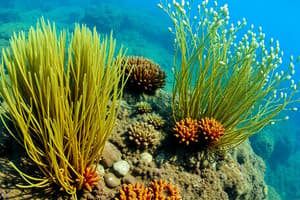Podcast
Questions and Answers
What abiotic factor is MOST important for determining a plant's preferred habitat?
What abiotic factor is MOST important for determining a plant's preferred habitat?
- Availability of sunlight (correct)
- Availability of mates
- Availability of other plants
- Availability of predators
Which of the following is NOT a characteristic that defines a habitat?
Which of the following is NOT a characteristic that defines a habitat?
- Presence of predators
- Availability of food
- The number of species within the habitat (correct)
- Specific climate conditions
How do organisms adapt to their habitat?
How do organisms adapt to their habitat?
- By creating new habitats
- By changing the habitat to suit their needs
- By developing specific traits that aid their survival in that environment (correct)
- By migrating to a different habitat
What is the main reason why species might have similar habitat needs but not overlap in distribution?
What is the main reason why species might have similar habitat needs but not overlap in distribution?
What is a major threat to biodiversity that is directly related to habitats?
What is a major threat to biodiversity that is directly related to habitats?
Flashcards
Ecosystems
Ecosystems
Biological communities of interacting organisms and their environment.
Energy Flow
Energy Flow
Energy moves in one direction from the sun to producers to consumers.
Nutrient Cycling
Nutrient Cycling
Nutrients in ecosystems are recycled and reused by organisms.
Habitats
Habitats
Signup and view all the flashcards
Habitat Loss
Habitat Loss
Signup and view all the flashcards
Study Notes
Ecosystems
- Ecosystems are biological communities of interacting organisms and their physical environment.
- They encompass both biotic (living) and abiotic (non-living) components.
- Key characteristics include the flow of energy and the cycling of nutrients.
- Energy flows through the ecosystem in one direction, typically from the sun through producers (plants) to consumers (animals).
- Nutrients are recycled within the ecosystem, returning to the environment and being reused.
- Different ecosystems have varying levels of biodiversity and are shaped by unique environmental factors like climate, geography, and substrate.
- Ecosystems can be classified into different types based on their dominant characteristics, such as terrestrial (forests, grasslands, deserts), freshwater (lakes, rivers, swamps), and marine (oceans, coral reefs).
Habitats
- Habitats are specific environments where particular species live and thrive.
- Habitats are characterized by specific abiotic factors such as climate, temperature, water availability, and sunlight.
- They also include the biotic factors of the ecosystem, like the availability of food and predators.
- Living organisms adapt to their habitat by developing specialized traits.
- The physical and chemical properties of habitat determine the organisms able to survive in those conditions.
- A species' needs and adaptations help dictate its preferred habitat.
- Different species may have similar habitat needs but not necessarily overlap.
- Competition among species for resources can play a crucial role in habitat selection and distribution.
- Habitat loss and degradation are significant threats to biodiversity.
- A species' habitat correlates with its survival and reproduction potential.
- Organisms in a habitat have specific roles.
- Different ecosystems contain a variety of habitats.
- Human activities can impact habitats, sometimes with detrimental effects.
Studying That Suits You
Use AI to generate personalized quizzes and flashcards to suit your learning preferences.




